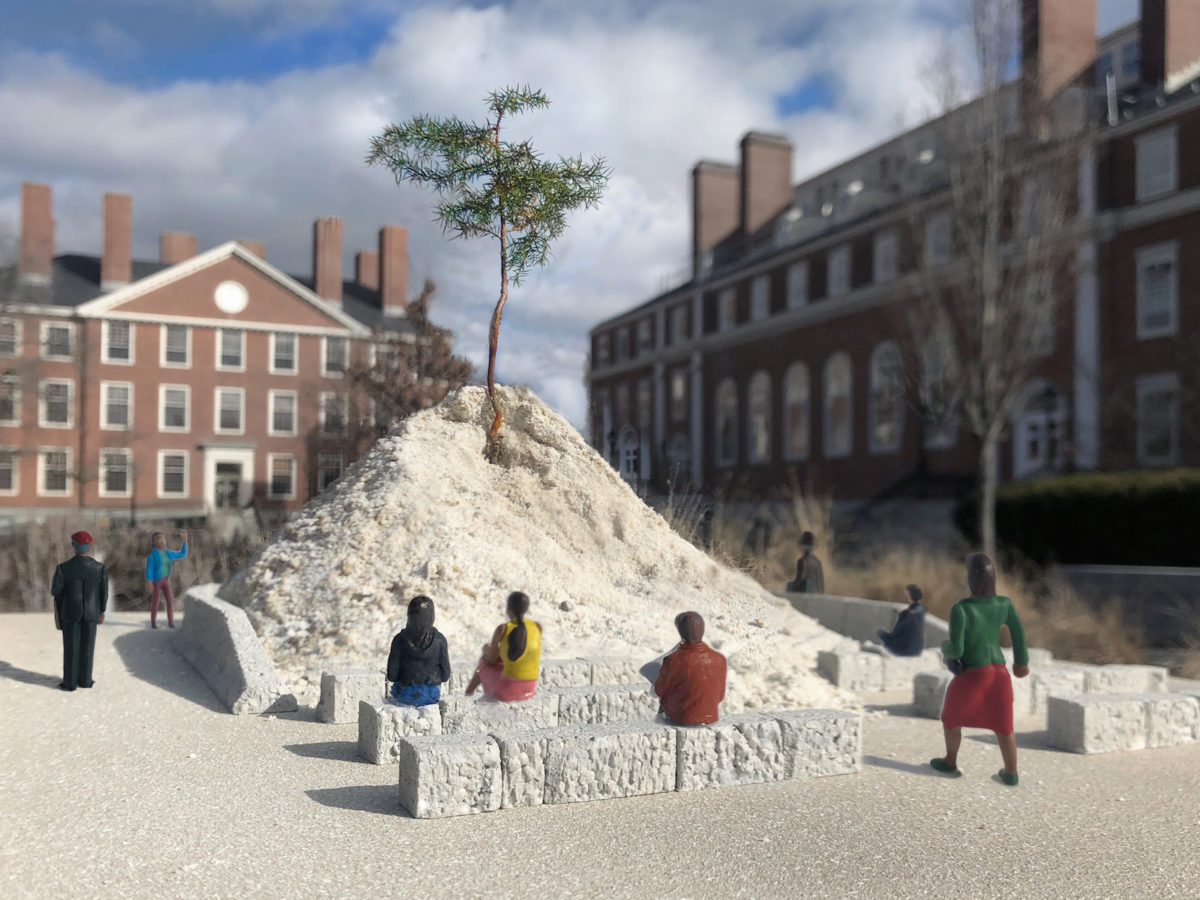Harvard Graduate School of Design students Isaac Stein (MLA/MDes ’20) and Maggie Tsang (MDes ’19) won first-place in this year’s Radcliffe Institute Public Art Competition (RIPAC), the competition’s fourth cycle. Stein and Tsang’s winning design, “A Pine in the Sand,” offers a poetic design narrative on environmental changes and processes, and their intersections with time and with human activity.
“A Pine in the Sand” joins a series of previous RIPAC-winning GSD projects, which will be on view through June 30 at the Radcliffe Institute for Advanced Study’s Johnson-Kulukundis Family Gallery (Byerly Hall, 8 Garden Street).
The biennial RIPAC contest seeks and supports a public-art project to be installed in the Radcliffe Institute’s Susan S. and Kenneth L. Wallach Garden, off Brattle Street in Radcliffe Yard. Stein and Tsang’s project was chosen from among 38 entries from 21 teams and 17 individuals in the 2017-2018 cycle. Their win provides $40,000 to bring their concept to life, as well as a $10,000 cash prize.
 “A Pine in the Sand” presents a pine tree atop a mound of white sand, with rows of granite benches facing the mound of sand. As natural (and other) elements erode and shape-shift the sand pile, the pile will be periodically documented and reshaped during events over the course of a full year. The intent is to draw attention to the seemingly latent maintenance essential to preserving our built and natural environments.
“A Pine in the Sand” presents a pine tree atop a mound of white sand, with rows of granite benches facing the mound of sand. As natural (and other) elements erode and shape-shift the sand pile, the pile will be periodically documented and reshaped during events over the course of a full year. The intent is to draw attention to the seemingly latent maintenance essential to preserving our built and natural environments.
“Radcliffe’s competition was an opportunity for us to rethink the concept of public art, site, and the built environment as static, and to highlight processes of degradation and change,” Stein and Tsang said in a written statement. “We are very excited to work through the details of this idea with the Radcliffe team to demonstrate that maintenance is not an afterthought, but an integral process.”
Robin Kelsey, Harvard University’s dean of arts and humanities, the Shirley Carter Burden Professor of Photography, and one of the competition’s faculty jurors, says, “‘A Pine in the Sand’ combines the kind of interest in entropy we associate with 1960s land art and conceptualism with a 21st-century concern for the dramatic fragility of living systems. It’s a brilliant concept, and I am eager to see it come into being.”
Yukio Lippit, professor of history of art and architecture and Radcliffe’s Johnson-Kulukundis Family Faculty Director of the Arts, adds, “‘A Pine in the Sand’ proposes something of a conundrum: a monument to impermanence. The design harmonizes a range of seemingly conflicting qualities in a wonderful way. On the one hand, it comes across as dislocated, raw, and vulnerable, but on the other hand it is poetic and oddly beautiful. Its interactive dimension is crucial, and it will bring a sense of surprise and whimsy to Radcliffe Yard. It is certain to challenge and elicit varied responses from its audiences, as the best public art often does.”
Stein and Tsang follow a series of GSD wins in the RIPAC competition. John Wang (MArch ’21), who entered the competition while an undergraduate at Harvard College, triumphed in 2016 with “100+ Years at 73 Brattle,” which has been on view since September 2017. Wang’s installation highlights the footprints of three buildings that previously occupied the site over the course of a century. In 2014’s cycle, Christina Leigh Geros (MLA/MAUD ’15) won the prize with project “Latent (e)Scapes,” comprising thousands of 1/8-inch acrylic rods, embedded with LEDs and hooked up to sensors, transforming the garden into a glowing landscape at night. And, in 2012, Keojin Jin and Juhun Lee (both MDes ’14) won with “Saturate the Moment,” an undulating structure fabricated from fiberglass strips and fishing lines, a “self-irrigating installation” designed to capture moisture from the air and return it to the ground beneath.
Finalist projects in the 2017-2018 RIPAC included a number of other GSD students as well: “Stacked Matter” by David Solomon (MArch ’19) and Jung Chan Yee (MArch ’18); “A House for Everyone” by Morgan Starkey (MArch ’18), Khoa Vu (MArch ’18), and Wilson Harkhono (MArch ’19); “Over the Borders” by Daniel Shieh and Je Sung Lee (both MDes ’19); and “CO-NET STAGE” by Mia Ming Guo (MDes ’19), Ao Li (MDes ’19), and Ningxin Cheng (MArch ’19).
Stein and Tsang prepare to install “A Pine in the Sand” over the upcoming summer and fall. Winning projects from past cycles by Wang, Geros, Jin, and Lee will be on view in the Johnson-Kulukundis Family Gallery (8 Garden Street, Radcliffe Yard) from May 3 through June 30 as part of the Radcliffe exhibition “Art in the Yard: Students Make Art Public at Radcliffe,” which also includes a gallery of the 2017-2018 finalists’ work.




